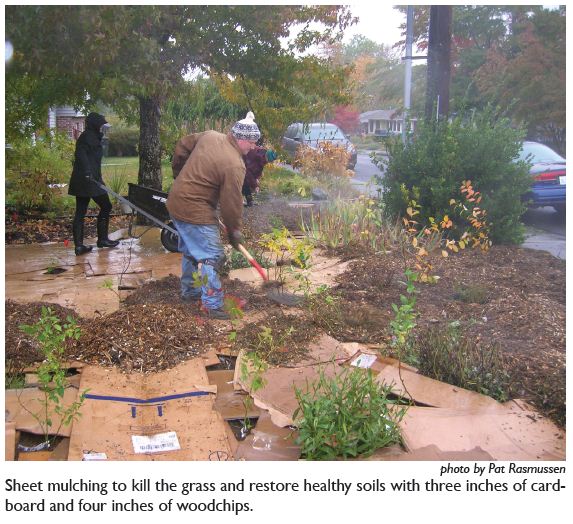Edible Forest Gardening TogetherBy Pat Rasmussen
Terri Plewa at 1815 Bigelow has turned her side yard into an Edible Forest Garden with a hazelnut hedge, four fruit trees - two pears, an apple and a plum - and many berries - blueberries, aronia berries, currants, raspberries, hardy kiwis, rosa rugosa and strawberries. Her three hugelkulturs will provide a place to grow greens for the two single moms with kids sharing the home. Hugelkulturs are similar to raised beds, but we dig down 6-12 inches and fill it in with pieces of wood, then top it off with soil and compost. The wood acts like a sponge to hold and provide water for the plants without irrigation and releases nutrients to grow healthy, robust plants. A patio area with tables will provide space for community members to get together for skill sharing, potlucks, classes and music - Olympia Village Building Convergence style. Lynn and Brad Corliss of 1834 Bigelow have a yard near where neighborhood kids wait for the school bus. "I noticed that my son and his friends were climbing existing trees and hiding under bushes, so I decided to turn empty space into a children's edible forest garden where the kids could play and eat fruit, nuts and berries as they wait for the bus before and after school. Talking about it to my neighbors, ideas catapulted one after another and coalesced into us helping each other each plant a garden in our yards. We planted two apricots, a fig and a peach tree and abundant berry bushes - elderberry, serviceberry, aronia berry, blueberry, rosa rugosa, strawberry, salmonberry, thimbleberry, evergreen huckleberry, salal, tall Oregon grape, and black twinberry, with hiding places for kids to play in and trails through the trees and bushes. This is in addition to a number of fruit trees we already have in the yard around our home," mused Lynn Corliss. Marja Eloheimo of 1840 Bigelow says, "My medicinal garden is designed with an emphasis on body systems, directions, and heritage. It was established several years ago but has been mostly unused for the last two years. The intention of reclaiming the garden is to make local medicine more available to the community through interacting with the plants themselves and through sharing knowledge about how to simply and safely prepare and use kitchen-based medicines." Marilyn Dungan of 1821 Bigelow will plant an Edible Forest Garden in her back yard in January as will other neighbors. One neighbor's yard is too shady for a garden, but she has chickens and will benefit from sharing and trading with her neighbors. These neighbors have worked together hauling cardboard, getting donated woodchips, planting the plants, sheet mulching with three layers of cardboard and four inches of woodchips, and planning for their future together as friends and neighbors, sharing food and medicines. They have rallied friends and neighbors to help install the gardens and inspired others to follow their lead. They provide a model for what many of us could do to make Olympia neighborhoods more "food secure" with local, organic, healthy foods grown in our yards. For more info go to http://www.oly-wa.us/edibleforestgardens
Back to Home page. |

 In the Upper Eastside Neighborhood, five neighbors are working together to create an Edible Forest Garden hub at the intersection of Bigelow and Turner.
In the Upper Eastside Neighborhood, five neighbors are working together to create an Edible Forest Garden hub at the intersection of Bigelow and Turner.